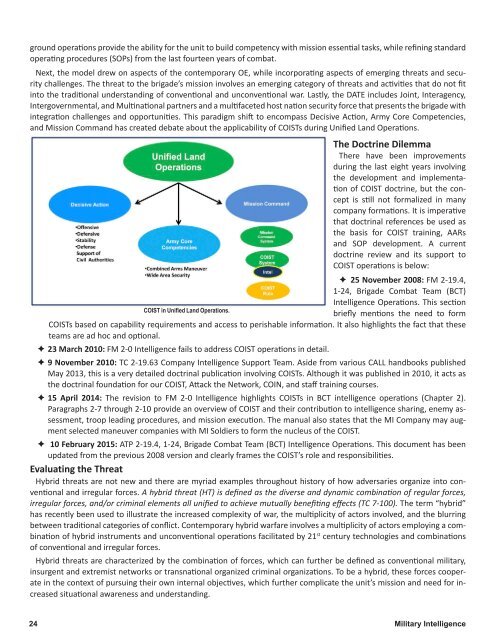incorrect
2015_02
2015_02
- No tags were found...
You also want an ePaper? Increase the reach of your titles
YUMPU automatically turns print PDFs into web optimized ePapers that Google loves.
ground operations provide the ability for the unit to build competency with mission essential tasks, while refining standard<br />
operating procedures (SOPs) from the last fourteen years of combat.<br />
Next, the model drew on aspects of the contemporary OE, while incorporating aspects of emerging threats and security<br />
challenges. The threat to the brigade’s mission involves an emerging category of threats and activities that do not fit<br />
into the traditional understanding of conventional and unconventional war. Lastly, the DATE includes Joint, Interagency,<br />
Intergovernmental, and Multinational partners and a multifaceted host nation security force that presents the brigade with<br />
integration challenges and opportunities. This paradigm shift to encompass Decisive Action, Army Core Competencies,<br />
and Mission Command has created debate about the applicability of COISTs during Unified Land Operations.<br />
The Doctrine Dilemma<br />
There have been improvements<br />
during the last eight years involving<br />
the development and implementation<br />
of COIST doctrine, but the concept<br />
is still not formalized in many<br />
company formations. It is imperative<br />
that doctrinal references be used as<br />
the basis for COIST training, AARs<br />
and SOP development. A current<br />
doctrine review and its support to<br />
COIST operations is below:<br />
25 November 2008: FM 2-19.4,<br />
1-24, Brigade Combat Team (BCT)<br />
Intelligence Operations. This section<br />
COIST in Unified Land Operations.<br />
briefly mentions the need to form<br />
COISTs based on capability requirements and access to perishable information. It also highlights the fact that these<br />
teams are ad hoc and optional.<br />
ÊÊ23 March 2010: FM 2-0 Intelligence fails to address COIST operations in detail.<br />
ÊÊ9 November 2010: TC 2-19.63 Company Intelligence Support Team. Aside from various CALL handbooks published<br />
May 2013, this is a very detailed doctrinal publication involving COISTs. Although it was published in 2010, it acts as<br />
the doctrinal foundation for our COIST, Attack the Network, COIN, and staff training courses.<br />
ÊÊ15 April 2014: The revision to FM 2-0 Intelligence highlights COISTs in BCT intelligence operations (Chapter 2).<br />
Paragraphs 2-7 through 2-10 provide an overview of COIST and their contribution to intelligence sharing, enemy assessment,<br />
troop leading procedures, and mission execution. The manual also states that the MI Company may augment<br />
selected maneuver companies with MI Soldiers to form the nucleus of the COIST.<br />
Ê Ê 10 February 2015: ATP 2-19.4, 1-24, Brigade Combat Team (BCT) Intelligence Operations. This document has been<br />
updated from the previous 2008 version and clearly frames the COIST’s role and responsibilities.<br />
Evaluating the Threat<br />
Hybrid threats are not new and there are myriad examples throughout history of how adversaries organize into conventional<br />
and irregular forces. A hybrid threat (HT) is defined as the diverse and dynamic combination of regular forces,<br />
irregular forces, and/or criminal elements all unified to achieve mutually benefiting effects (TC 7-100). The term “hybrid”<br />
has recently been used to illustrate the increased complexity of war, the multiplicity of actors involved, and the blurring<br />
between traditional categories of conflict. Contemporary hybrid warfare involves a multiplicity of actors employing a combination<br />
of hybrid instruments and unconventional operations facilitated by 21 st century technologies and combinations<br />
of conventional and irregular forces.<br />
Hybrid threats are characterized by the combination of forces, which can further be defined as conventional military,<br />
insurgent and extremist networks or transnational organized criminal organizations. To be a hybrid, these forces cooperate<br />
in the context of pursuing their own internal objectives, which further complicate the unit’s mission and need for increased<br />
situational awareness and understanding.<br />
24 Military Intelligence


